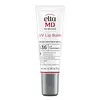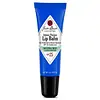What's inside
What's inside
 Key Ingredients
Key Ingredients

 Benefits
Benefits

 Concerns
Concerns

 Ingredients Side-by-side
Ingredients Side-by-side

Ethylhexyl Methoxycinnamate 7.5%
UV AbsorberZinc Oxide 7%
Cosmetic ColorantPetrolatum
EmollientRicinus Communis Seed Oil
MaskingCetearyl Alcohol
EmollientWater
Skin ConditioningLauryl Laurate
Skin ConditioningAroma
Polyethylene
AbrasiveOlea Europaea Fruit Oil
MaskingHydrogenated Soybean Oil
EmollientBeeswax
Emulsion StabilisingGlycerin
HumectantGlyceryl Behenate
EmollientCopernicia Cerifera Wax
Euphorbia Cerifera Wax
Hydrogenated Castor Oil
EmollientHydrolyzed Caesalpinia Spinosa Gum
AbsorbentMicrocrystalline Wax
Emulsion StabilisingCaesalpinia Spinosa Gum
Skin ConditioningSodium Benzoate
MaskingPotassium Sorbate
PreservativeAscorbyl Palmitate
AntioxidantThioctic Acid
AntioxidantTocopheryl Acetate
AntioxidantQuercetin
AntioxidantEthylhexyl Methoxycinnamate 7.5%, Zinc Oxide 7%, Petrolatum, Ricinus Communis Seed Oil, Cetearyl Alcohol, Water, Lauryl Laurate, Aroma, Polyethylene, Olea Europaea Fruit Oil, Hydrogenated Soybean Oil, Beeswax, Glycerin, Glyceryl Behenate, Copernicia Cerifera Wax, Euphorbia Cerifera Wax, Hydrogenated Castor Oil, Hydrolyzed Caesalpinia Spinosa Gum, Microcrystalline Wax, Caesalpinia Spinosa Gum, Sodium Benzoate, Potassium Sorbate, Ascorbyl Palmitate, Thioctic Acid, Tocopheryl Acetate, Quercetin
 Reviews
Reviews

Ingredients Explained
These ingredients are found in both products.
Ingredients higher up in an ingredient list are typically present in a larger amount.
Aroma refers to an ingredient, or mixture of ingredients, that impart or mask a flavor.
The name is slightly confusing. This is because INCI associates aroma with flavor instead of smell.
Here is the official definition from the The International Cosmetic Ingredient Dictionary and Handbook:
“Aroma is a term for ingredient labeling used to identify that a product contains a material or combination of materials normally added to a cosmetic to produce or to mask a particular flavor.”
INCI shows the only purpose of aroma to be "flavouring".
However, due to regulation differences, some companies may use aroma in place of parfum.
In Canada, this ingredient only has to be listed in concentrations above 1%.
Learn more about AromaBeeswax is natural wax produced by honey bees and can be synthetically created. It consists mainly of fatty acid esters and long-chain alcohols.
In cosmetics, beeswax is a emollient. Due to its waxy structure, it creates a protective barrier. This barrier prevents water from evaporating off the skin.
This may not be a good ingredient for oily skin. We recommend speaking with a professional if you have concerns.
Beeswax cannot be removed with water, but can be taken off with an oil cleanser.
Beeswax is also antiseptic and contains vitamin A.
Learn more about BeeswaxMicrocrystalline Wax is created by de-oiling petroleum. It is highly refined and purified before being added to cosmetics.
Microcrystalline Wax is used to enhance the texture and create even consistency. It helps stabilize a product by preventing ingredients from separating.
Tocopheryl Acetate is AKA Vitamin E. It is an antioxidant and protects your skin from free radicals. Free radicals damage the skin by breaking down collagen.
One study found using Tocopheryl Acetate with Vitamin C decreased the number of sunburned cells.
Tocopheryl Acetate is commonly found in both skincare and dietary supplements.
Learn more about Tocopheryl Acetate